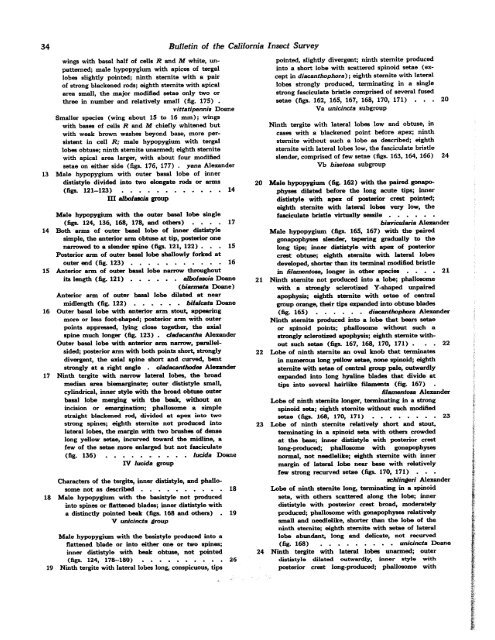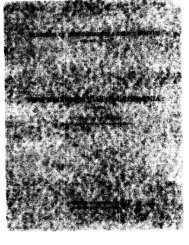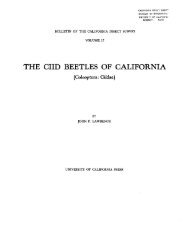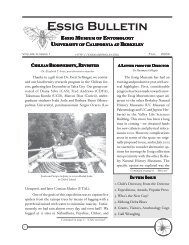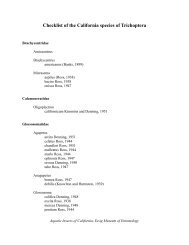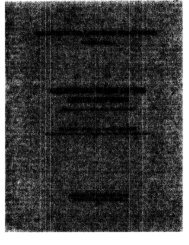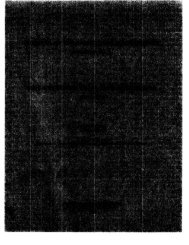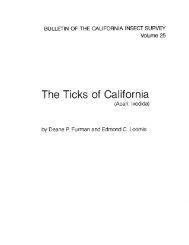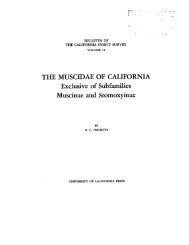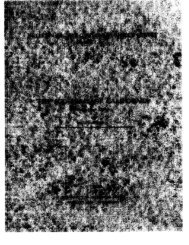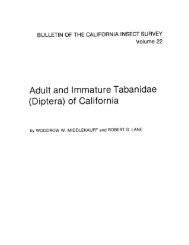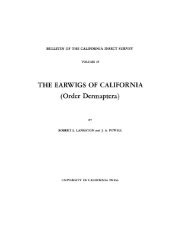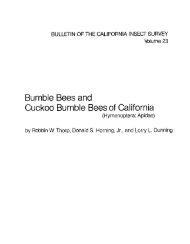The Crane Flies of California - Essig Museum of Entomology ...
The Crane Flies of California - Essig Museum of Entomology ...
The Crane Flies of California - Essig Museum of Entomology ...
Create successful ePaper yourself
Turn your PDF publications into a flip-book with our unique Google optimized e-Paper software.
34 Bulletin <strong>of</strong> the <strong>California</strong> Insect Survey<br />
13<br />
wings with basal half <strong>of</strong> cells R and M white, unpatterned;<br />
male hypopygium with apices <strong>of</strong> tergal<br />
lobes slightly pointed; ninth sternite with a pair<br />
<strong>of</strong> strong blackened rods; eighth Sternite with apical<br />
area small, the major modified setae only two or<br />
three in number and relatively small (fig. 175) .<br />
vittatipennis Doane<br />
Smaller species (wing about 15 to 16 mm); wings<br />
with bases <strong>of</strong> cells R and M chiefly whitened but<br />
with weak brown washes beyond base, more persistent<br />
in cell R; male hypopygium with tergal<br />
lobes obtuse; ninth sternite unarmed; eighth sternite<br />
with apical area larger, with about four modified<br />
setae on either side (figs. 176, 177) . yana Alexander<br />
Male hypopygium with outer basal lobe <strong>of</strong> inner<br />
dististyle divided into two elongate rods or arms<br />
(figs. 121-123) . . . . . . . . . . . . 14<br />
I11 alhfaacia group<br />
Male hypopygium with the outer basal lobe single<br />
(figs. 124, 136, 168, 178, and othm) . . . . 17<br />
14 Both arms <strong>of</strong> outer basal lobe <strong>of</strong> inner dististyle<br />
simple, the anterior ann obtuse at tip, poseor one<br />
narrowed to a slender spine (figs. 121, 122) . . . 15<br />
Posterior arm <strong>of</strong> outer basal lobe shallowly forked at<br />
15<br />
outer end (fig. 123) . . . . . . . . . . . 16<br />
Anterior arm <strong>of</strong> outer b l<br />
lobe narrow throughout<br />
its length (fig. 121) . . . . . . alib<strong>of</strong>ascia Doane<br />
(biclrmata Doane)<br />
Anterior arm <strong>of</strong> outer basal lobe dilated at near<br />
. . . . . . bifdcata Doane<br />
midlength (fig. 122)<br />
16 Outer basal lobe with anterior arm stout, appearing<br />
more or less foot-shaped; posterior arm with outer<br />
points appressed, lying close together, the axial<br />
spine much longer (fig. 123) . dad-tha Alexander<br />
Outer basal lobe with anterior ann narrow, parallelsided;<br />
posterior arm with both points short, strongly<br />
divergent, the axial spine short and curved, bent<br />
strongly at a right angle . dadacanthodea Alexander<br />
17 Ninth tergite with narrow lateral lobes, the broad<br />
median area bieanarginate; outer dististyle small,<br />
cylindrical, inner style with the broad obtuse outer<br />
basal lobe merging with the beak, without an<br />
incision or emargination; phallosome a simple<br />
straight bladrened rod, divided at apex into two<br />
strong spines; eighth sternite not produced into<br />
lateral lobes, the margin with two brushes <strong>of</strong> dense<br />
long yellow setae, incurved toward the midline, a<br />
few <strong>of</strong> the setae more enlarged but not fasciculate<br />
(fig. 136) . . . . . .. . . . . lucida Doane<br />
IV lucida group<br />
18<br />
19<br />
Characters <strong>of</strong> the tergite, inner dististyle, and phallosome<br />
not as described . . . . . . . . . . 18<br />
Male hypopygium with the basistyle not produced<br />
into spines or flattened blades; inner dististyle with<br />
a distinctly pointed beak (figs. 168 and othem) . 19<br />
V unicincta @up<br />
Male hypopygium with the basistyle produced into a<br />
flattened blade or into either one or two spines;<br />
inner dististyle with beak obtuse, not pointed<br />
(figs. 124, 178-180) . . . . . . . . . . 26<br />
Ninth tergite with lateral lobes long, conspicuous, tips<br />
pointed, slightly divergent; ninth sternite produced<br />
into a short lobe with scattered spinoid setae (except<br />
in diacanthophora) ; eighth sternite with lateral<br />
lobes strongly produced, terminating in a single<br />
strong fasciculate bristle comprised <strong>of</strong> several fused<br />
setae (figs. 162, 165, 167, 168, 170, 171) . . . 20<br />
Va unicincta subgroup<br />
Ninth tergite with lateral lobes low and obtuse, in<br />
cases with a blackened point before apex; ninth<br />
sternite without such a lobe as described; eighth<br />
sternite with lateral lobes low, the fasciculate bristle<br />
slender, comprised <strong>of</strong> few setae (figs. 163, 164, 166) 24<br />
Vb bisetosa subgroup<br />
20 Male hypopygium (fig. 162) with the paired gonapophyses<br />
dilated before the long acute tips; inner<br />
dististyle with apex <strong>of</strong> posterior crest pointed;<br />
eighth sternite with lateral lobes very low, the<br />
21<br />
22<br />
fasciculatebristlevirtuallysessile . . . . . .<br />
biavicularia Alexander<br />
Male hypopygium (figs. 165, 167) with the paired<br />
gonapophyses slender, tapering gradually to the<br />
long tips; inner dististyle with apex <strong>of</strong> posterior<br />
crest obtuse; eighth sternite with lateral lobes<br />
developed, shorter than its terminal modified bristle<br />
infilamentoaa,longerinotherspecies . . . . 21<br />
Ninth sternite not produced into a lobe, phallosome<br />
with a strongly sclerotized Y-shaped unpaired<br />
apophysis; eighth sternite with setae <strong>of</strong> central<br />
group orange, their tips expanded into obtuse blades<br />
(fig. 165) . . . . . . di-thophora Alexander<br />
Ninth sternite produced into a lobe that bears setae<br />
or spinoid points; phallosome without such a<br />
strongly sclerotized apophysis; eighth sternite without<br />
such setae (figs. 167, 168, 170, 171) . . . 22<br />
Lobe <strong>of</strong> ninth stemita an oval knob that ttuminates<br />
in numerous long yellow setae, none spinoid; eighth<br />
sternite with setae <strong>of</strong> central p up pale, outwardly<br />
empanded into long hyaline blades that divide at<br />
tips into several hairlike filaments (fig. 167) .<br />
Hamentosa Alexander<br />
Lobe <strong>of</strong> ninth sternite longer, terminating in a strong<br />
spinoid seta; eighth sternite without such modified<br />
setae


